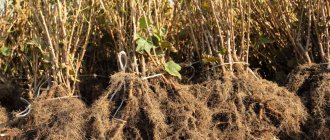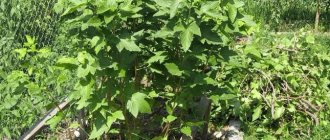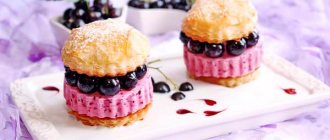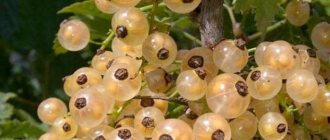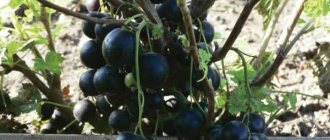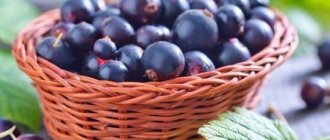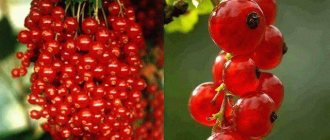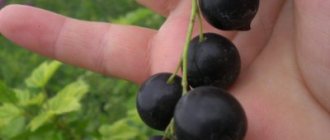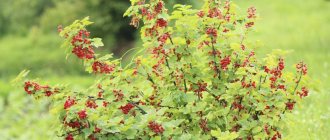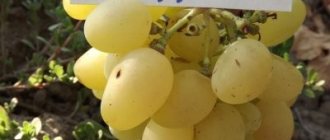“Natalie” is the most popular variety of berries in the suburban areas of our country. It is characterized by excellent productivity, tasty berries, and immunity to various diseases. Most people who have chosen this variety for themselves confirm this.
red currant variety "Natalie"
The advantage of the Natalie variety is the impressive size of the berries and good taste
“Natalie” currants are superior to many varieties in terms of sugar content in berries, yield and resistance to frost
History of selection and region of breeding
This type of red currant was bred through interspecific crossing in VSTISP by V. M. Litvinova and N. K. Smolyaninova. In 1991, this variety was included in the list of the State Register of Breeding Achievements. It is also recommended for planting in almost many regions of Russia.
The currant itself is an unpretentious berry and does not require special care. Therefore, the Natalie variety can be grown in almost all regions of Russia. With the exception of the Lower Volga and Northern agricultural enterprises and summer cottages. Also, the variety is not popular in the Far East of our country.
The best region for growing this type of currant will be central Russia.
Reviews about the variety
The description of the variety will not leave anyone indifferent to Natalie’s red currant. Gardeners who decide to grow this crop on their personal plot leave mostly positive reviews on various gardening forums.
They note the pleasant sour-sweet taste, good presentation and high transportability of the berries. The harvested crop can be stored in the freezer for a whole year.
According to gardeners, the shrub is able to successfully survive the winters of central Russia (withstands frosts down to -30). In addition, it is resistant to diseases and pests. Its productivity is high, the bush bears fruit consistently for 10 years. Ripe berries practically do not fall off, and picking them is simple and convenient.
Negative reviews about Natalie's currants are extremely rare. They only note that by the fifth year of life, due to abundant harvests, the bushes become spreading. The shoots need additional supports.
As you can see, the variety has many positive qualities, moreover, they are more significant than the only drawback that can be eliminated on your own. It is for this reason that Natalie’s red currant has gained such great popularity among domestic gardeners.
Main characteristics of the Natalie variety
“Natalie” has a bush with a weak spread, but it is medium-sized and rather dense. It has straightened green shoots, usually not very thick, without pubescence. They are colored green with reddish tops, which is a distinctive feature of this type of currant. And those shoots that have become lignified are brownish in color, also without pubescence.
The leaves of "Natalie" are five-lobed, medium-sized, not pubescent, slightly wrinkled and leathery. They are characterized by a green color with a slight blue tint, and they themselves have a matte appearance with a wavy edge. The petiole is also green in characteristics, of normal length and the same thickness, not pubescent.
The Natalie variety is distinguished by its large flowers with cup-shaped sepals of a dark red color. This type of currant has an average cluster size of up to 10 cm with a dense axis with pubescence.
Large and strong berries that gain weight from 0.7 to 1 g. They look round, slightly stretched. They are characterized by a deep red color and contain a number of small seeds inside. All berries are uniform in appearance.
The variety has a dry detachment, but does not have excessive aridity. It is covered with a fairly dense layer of skin, which makes it possible to successfully transport the berries.
Berries of the Natali variety have a sweet and sour, but overall very pleasant taste. According to many tasters, the average taste score is 8 out of 10.
The amount of sugar in this type of currant is 6.5% and 39 mg of glucose per 100 g of product.
Description of the variety
Natalie's red currant berries are quite large, their average weight is 0.7-0.8 g (the record-breaking fruits weigh 1 g). They are round, but slightly elongated at the base. The berries have a rich dark red color and thick skin.
The pulp has a uniform structure. There are a small number of small seeds inside the fruit. The number of brushes that form on a shrub depends on the conditions in which it is grown. The peduncle is green, medium length. There is no pubescence on it.
Tasting score - 4 points out of 5. Natalie's red currant fruits contain sugar (6.6%) and ascorbic acid (40 mg/100 g). Refers to varieties of medium ripening (second half of July). Ripe fruits do not fall off the cluster. Natalie's currants have denser berries than blackcurrant varieties, so they are better stored and withstand transportation, while maintaining their presentation.
The Natalie currant bush reaches a height of 1.5 m. The shoots (both young and perennial) are erect. One bush can have from 15 to 20 stems. Perennial shoots are woody, gray-brown. Every year the bush produces a sufficient number of young green (and reddish at the tops) stems.
The entire underground part is also well developed. Thanks to its powerful long roots, the shrub rarely experiences a lack of water.
The leaf blade is medium in size, wrinkled, without pubescence. The edges are jagged, at the top of the bush the leaves are curved. The leaf color is green, but with a slight bluish tint. Buds are single, elongated, pointed. They are pressed to the stem. The flowers are large, cup-shaped, they are collected in a dense racemose inflorescence. Together with the petiole, the brush reaches a length of 7-9 cm.
The bush bears fruit consistently for 10 years. It tolerates frosty winters well, has strong immunity to diseases and is highly resistant to pests.
Features of the variety
It is necessary to know the characteristics of the variety before you start growing it. Below you will find out the currant ripening period, yield, transportability and other features.
Maturation period
“Natalie” is a medium-ripening variety. This implies that this type of currant needs approximately 125-135 days to fully ripen.
The best month for harvesting will be mid-July. But it is also possible to mow until the beginning of August, depending on growing conditions.
If the overall air temperature is too low, which is possible during cold summers, this will lead to one problem with the berries. This particular variety is not afraid of frost, but it does not tolerate the lack of moisture without difficulty. This can affect the taste of the berries and the condition of the bush itself in the future.
Productivity
"Natalie" is distinguished by its impressive and abundant yield. One bush can produce approximately 3.6 kg of berries. This is much more than can be collected from other varieties of currants. So, for comparison, “Gazelle” and “Orlovskaya Zvezda” give 2 kg and 2.3 kg, respectively.
The video below shows the Natalie currant variety:
The numbers definitely show a significant advantage for Natalie in terms of the number of berries collected.
This yield is due to the fact that the variety is self-fertile. This means that during pollination, the currant variety uses only the pollen of its flowers without third-party pollinators, which can be, for example, bees.
In fact, the variety is independent and is able to develop and grow without human intervention. But to achieve the highest yield, it is better not to avoid outside influence. The plant can do without care and fertilizer, but then the results during harvest will be disappointing.
Thus, due to the unusual structure of the flower of the currant bush and the same non-standard pollination process, a good harvest can be harvested even in less than favorable conditions and places.
Drought and frost resistance
Moisture is an important component, without which the red currant variety “Natalie” is almost incapable of further life activity. Although the variety is considered drought-resistant, that is, it is able to calmly endure days of drought, it reacts very sharply to a lack of water during flowering.
When forming currant berries, such a component as satisfactory watering during ripening is taken into account. It is this that will ultimately influence the size, taste and overall yield of berries. So the “Natalie” variety can be considered drought-resistant, but completely depriving it of moisture is strictly not recommended.
As for frost resistance, the variety is absolutely indifferent to cold and is able to ignore frost down to -25 °C. It also tolerates cold summer days calmly and without any problems.
Thus, the “Natalie” variety is boldly called drought-resistant and frost-resistant. This is one of its main advantages over other varieties of these berries.
Resistance to diseases and pests
"Natalie" is considered the strongest and healthiest type of red currant. No other variety has such good resistance to plant pests and diseases of garden flora.
The only point due to which “Natalie” can be attacked by plant viruses is improper planting and ignoring the techniques for growing and caring for red currants. These negative and harmful measures may well weaken the bush’s immunity and turn it into a target for garden diseases.
Transportability
You can transport both bunches and berries separately, and they will retain their presentable appearance for a long time. Also, the “Natalie” variety can easily cope with transportation over long distances without losing its taste qualities.
So that during transportation our type of currant does not lose its best qualities and does not deteriorate at all, it is recommended to transport the berries and bunches in small containers to preserve the layer at the bottom of the berries themselves.
Pests and diseases
The Natalie variety is resistant to many diseases and pests: anthracnose (brown spot), powdery mildew and gall aphids. The risk of injury cannot be completely excluded. Therefore, in early spring (March - early April), it is recommended to treat the bushes with a fungicide: Bordeaux mixture, Fitosporin, Fundazol, Oksikhom, Captan.
If spots on the leaves and other symptoms of fungal diseases are noticed in the summer, the drugs are used with caution. Instead, summer residents often use folk remedies:
- weak solution of potassium permanganate;
- infusion of freshly cut weeds;
- fresh manure solution;
- milk or whey;
- ash.
Also, currant bushes of the Natalie variety can suffer from bud and spider mites, moths and other pests. They are also fought with folk remedies, as well as effective insecticides: “Aktara”, “Confidor”, “Fitoverm”, “Match”, “Decis”.
Important! After treating currant bushes of the Natali variety with chemicals, you must wait at least 3 days before harvesting. Spraying is best done in the evening, in dry and windless weather.
The main advantages and disadvantages of the variety
Having thoroughly analyzed the main characteristics of “Natalie”, we can highlight the main advantages and possible disadvantages.
Advantages:
- Frost resistance – withstands from -25 to -30 °C. This feature helps the variety to calmly cope with climatic and meteorological problems.
- Long lifespan. This advantage means a long fruiting process. A healthy bush has the ability to produce a good harvest for 10 years.
- The berries have a long shelf life - they do not fall off for an impressive period of time after they are finally ripe and ready for picking.
- The taste of the berries is sweet and sour, but pleasant.
- Convenient and comfortable transportability.
- Long shelf life.
- Resistance against pests and plant diseases.
The Natalie variety has almost no disadvantages. But experts highlight one unpleasant feature. After the bush has lived for more than 5 years, it becomes too large and spreading. Because of this, the shoots bend under the weight of the bunches of berries, being attracted to the ground and bending even more. To avoid this problem, it is necessary to use wooden supports.
Landing
Red currant "Natalie" can grow on any fertilized soil. But fertile loams and sandy loam soils with an arable horizon of more than 20-25 cm are considered the best. Light loams provided with humus from sandy loam are well suited. Currants do not like high acidity; if the pH is less than 5.5, the soil must be limed a year before planting. Excessively dry areas are also not desirable for Natalie.
It is best to plant bushes in early spring or late September.
For seedlings, choose flat, medium and elevated areas with good lighting. An ideal place for currants is near a fence, which will protect the bush in windy weather. The area is cleared of weeds.
The seedling is buried 5-10 cm into the ground. The branches are cut by half or more.
Currants do not need cross-pollination, but if it is present, the yield will increase, the berries will be larger and more tasty. For this purpose, different varieties of currants are planted on the site.
The intervals among the bushes are a meter and a half. The feeding area of each bush is 1-2 square meters. meters.
During the planting process, they are fertilized with horse manure or humus; it is useful to use superphosphates, potassium sulfate and wood ash.
The benefits of red currant
Red currant or, as it is also called, common currant, is a small shrub that belongs to the Gooseberry family. The calorie content is 39 kcal per 100 g. Among them are 0.6 g of protein, 0.2 g of fat and 11 g of carbohydrates.
It contains a significant amount of provitamin A. Red currants are also rich in biotin and beta-carotenes. The composition also contains organic and mineral substances, for example, iron, calcium, magnesium and sodium.
It is thanks to the presence of these useful components that red currants help strengthen bones and improve vision. It also maintains healthy scalp hair, softens and moisturizes the skin and stabilizes the immune system.
The substances contained in red currants are considered to be the most powerful antioxidants. They help cope with premature aging and activate the division of new cells in the body. Thus, red currants have the ability to prolong youth.
In addition, these already medicinal berries contain a unique component called oxycoumarin. It is responsible for the process of blood clotting and serves as a preventive effect against cardiovascular diseases such as heart attack.
Red currants are rich in pectins, which help remove excess cholesterol from the body, thereby lowering its level to an acceptable level and helping to avoid unpleasant and serious diseases associated with it.
The dietary fiber contained in red currants is of great benefit to people losing weight. Due to its low calorie content, you can safely add it to your diet and not be afraid of gaining weight. Therefore, currants are included in the diet when following a diet.
Many desserts and other table dishes are made from Natalie. It is used to make compotes, jams and jellies, and is also added to sauces and salads to add piquancy to the taste of the dish. Beautiful bunches of red currant berries can decorate a holiday table.
Care
Red currant "Natalie" needs watering two to three times a week. Each bush needs a bucket of water twice a day. During the fruiting phase, it is important to ensure sufficient soil moisture to prevent a decrease in yield in the future.
Currants need root and foliar feeding and mulching. At the end of September, 100 grams of superphosphate and 30 grams of potassium chloride are added to each bush. The bush is mulched with horse humus in the tree trunk area. This will help protect the bush from early frosts and snowless winters.
It is useful to transplant currants in autumn or spring. To do this, prepare a hole in advance, then water the bush well. Then they dig it up, protecting it with film, and plant it.
Landing Features
The Natalie currant variety has its own planting characteristics. Read about all the nuances below.
Selection of seedlings
If you decide to plant “Natalie” red currant bushes on your plot or in the garden, then you will find our advice useful on how to achieve the best results when purchasing young seedlings.
When choosing them, be guided by the following data:
- The seedlings are strong and grown. Their characteristics are 1-2 dense and not crooked shoots with an approximate length of about 25-45 cm.
- There are several healthy and noticeable buds on the shoots
- Seedlings ready for planting consist of 3-6 coarse skeletal roots, colored light yellow. The lateral roots must have a formed lobe system - that is, a system where there is no main root and mainly consists of adventitious roots.
It is best to buy seedlings from special nurseries and professional nurseries. This way you will be protected from deception and will be assured that you purchased exactly the right variety. And the likelihood that seedlings from the nursery will be infected with unpleasant diseases will be minimized.
Boarding time
The best time to plant Natalie is the end of April and the beginning of May. But it is also possible to plant the variety at the end of September for the winter, because it is frost-resistant. Although it is worth understanding that the seasons are fickle and you should focus not on a specific month, but on other factors.
The main condition that must be met is that the earth is warm enough. At temperatures below 14°C, it is not recommended to plant currants. In addition, it is necessary to moisten the prepared soil. Do not do this if there has been recent precipitation. The soil structure should look loose and plowed.
Soil preparation
After purchasing a seedling, you must carefully prepare the planting site:
- At the very beginning, rid the soil of weeds and unfavorable roots.
- Then thoroughly dig up the soil and loosen it thoroughly.
- Next, fertilize the soil. The best assistant for you will be a mixture of superphosphate, tree ash and simple humus. Distribute the fertilizer a meter from the intended location of a specific planting.
The most favorable soils for the Natalie variety are those with a high moisture capacity and a relatively neutral reaction. They contain the necessary ratio of microorganisms necessary for red currants and their successful growth. Examples of such soils are chernozem, clayey and sandy loam.
Currant propagation
The best time for breeding is the end of August and the beginning of September. It is necessary in order not to spend money on new seedlings, but to get them yourself. In this case, you will be absolutely sure that you will get what you wanted.
The easiest way to propagate the Natalie variety is to select a certain number of healthy shoots during pruning, remove all the leaves from them and cut them into pieces 20 cm long. Then they need to be processed in a root formation stimulator, where they take root, planted in nutritious soil.
Step-by-step planting diagram
Before planting the seedlings, planting holes should be made. The size of each is 25-35 cm and the width is 50-60 cm.
The landing procedure is carried out as follows:
- Lower the seedling into the hole and distribute the roots evenly.
- Tilt the seedling. This will help the development of lateral roots and young buds.
- Fill the hole halfway with soil and tamp the soil down thoroughly.
- Fill half a bucket with water.
- Fill in the remaining soil.
- Water the bush with 10-14 liters of water.
- Fertilize the soil around the seedling. You can use manure and sawdust.
- Trim the seedling so that the length of the shoots does not exceed 14 cm.
Natalie currant variety: summary
Red currants are very useful for both adults and children. Moreover, caring for her is easy and simple. Natalie grows well in the first year of planting, and produces a harvest in mid-summer. It is important to note that the fruits hang on the branches for a very long time and do not fall off. In addition, the berries are very beautiful and large, with a characteristic sweet taste. Currant bushes are quite spreading, so they should be trimmed and tied up in time. Water the currants on time, feed them and carry out preventive examinations, and they will definitely please you with their harvest. In addition to the beautiful name, this variety also has excellent fruits, so remember this variety and be sure to plant it on your site. He won't let you down.
Currant Natalie
Caring for red currants
Caring for the Natalie currant variety must be of high quality and timely. Read about all the features below.
We recommend reading the article on how to care for currant bushes in the autumn.
Watering
"Natalie" is unpretentious in watering and does not require much water. In summer, water it about once a week, and on dry days, increase watering to 2-3 times a week. For all this you need about 10 liters of water, its temperature should be at air level.
Watering “Natalie” is especially important during ripening. Water it every other day during this period so that the taste of the berries is as juicy and rich as possible.
Top dressing
“Natalie” needs feeding after 3 years of life. In the spring, fertilize the currant slices with compost diluted with water. In autumn, it is recommended to use mineral fertilizers, which need to be diluted with the soil of your site.
It will not be superfluous to regularly loosen the soil space around the currants and destroy weeds and other pests that adversely affect the microflora of the Natalie variety.
Mulching the soil is also considered necessary. For “Natalie” you should use sludge from a swamp or slurry from manure. This care will help retain water in the soil and contribute to an increase in elements useful for fertility and a good harvest. This will also insulate the root system and prevent the growth of weeds.
Trimming
Every season, the Natalie bush must undergo high-quality pruning. This is due to its main drawback - every year the plant grows and interferes with its own fertility.
You need to start in early spring, before the sap inside the branches begins to move. Trim old and dry branches that are unlikely to produce a good harvest. After finishing pruning, treat the affected areas with activated carbon.
Then, you need to trim the branches growing inside the plant. This is necessary so that in the future sunlight will not encounter obstacles on its way to the berries.
It is also sometimes necessary to carry out preventative pruning. Remove underdeveloped branches that are unlikely to grow anything. Do not spare broken and dry branches. Trim leaves that show signs of possible disease.
Harvest and storage
As previously described, the first berries of the “Natalie” variety appear in mid-July and on average you can harvest about 3.5 kg of berries from one bush. Therefore, already at this time it is necessary to think about harvesting.
In order not to damage the fruit bud, you need to be extremely careful when picking berries. First, you should lift the bunch a little and only then pick the harvest.
It is also easy to understand that the currant bunch is ripe. In its peak state, it separates extremely freely and seamlessly from the branch. Try not to damage the fruit branch.
The best time to pick berries is dry and windless weather. You can put currants in containers and trays. Then it should be packaged in glass jars. In this form, currants can stand in the refrigerator for up to 4 weeks.
To preserve currants throughout the year, you must first wash them thoroughly and then dry them. These procedures will remove unwanted bacteria from the body of the berries, which can speed up the rotting process. Next, the currants are packaged in bags and left in the freezer.
Preparing for winter
The red currant variety "Natalie" is one of the most frost-resistant. But this does not mean that you can neglect caring for the bush in winter.
To preserve the fertility of the currant plant and make wintering as easy as possible for it, cover the bush and the ground around it with humus or marsh silt.
In addition to protection from the cold, the plant will be protected from rodents and other pests that can damage young shoots. This can also serve as additional feeding for the bush.
Don't neglect mulching. Such measures to improve your plant will then return to you in the form of delicious berries and a strong plant with healthy shoots.
Rules for planting currants
The red currant variety Natalie is planted like regular currants. There are no nuances here.
Recommended timing
It is best to plant red currants in the fall, although there are no restrictions on timing. Natalie's currants can be planted throughout the entire growing season.
Choosing a suitable location
It should be a sunny area with protection from winds. The soil is preferably loamy with neutral acidity.
Important! Soils that are too acidic need liming with wood ash or lime.
Selection and preparation of planting material
For planting, seedlings about 2 years old and having at least three root branches are selected. Any preliminary preparation of seedlings, other than their visual inspection for defects or diseases, is not used.
Landing algorithm
A month before planting, holes are prepared with a depth of 40 cm and dimensions of 50 by 50 cm. They must be fertilized in advance in the form of a bucket of humus, about 200 g of superphosphate and 40-50 g of potassium fertilizers. All this should be thoroughly mixed and poured.
During planting, the seedlings are placed in a hole at an angle of 45 °, and their root collar goes deep into the ground by 5-6 cm. It is also desirable that several buds are below the ground level.
After sprinkling the seedling, water the planting site with 10 liters of water.
Diseases and pests
Although “Natalie” is one of the healthiest varieties of currants, pests and diseases do not always bypass it. Now we will analyze the main problems that may arise with the condition of the bush and their consistent solutions:
- Powdery mildew. At the end of summer, this disease may attack your bush. To cope with it, treat the bush with Topaz after the plant has flowered and two weeks before picking the berries.
- Anthracnose. To combat it you will need a solution of iron sulfate. To get it, you need to mix 300 g of the drug with 10 liters of water. If you have not neglected pruning, then this disease will bypass your bush.
- Leaf gall aphid. This plant pest attacks a currant bush as a whole colony and can stop the growth of stems and deform shoots. To eliminate aphids, you need to spray the bush with a solution of karbofos and destroy the damaged foliage.
- Gooseberry sawfly. To combat this pest, you must treat the currant bush with Iskra DE. And in order to prevent it, try not to neglect mulching.
Red currant Natalie: how to care
Red currant Natalie: how to care
This variety produces a bountiful harvest only with proper care, so carefully study this paragraph of the article. Currants need to be fed and watered on time. Before wintering, the shoots are pruned so that the plants develop better in the spring. And in order to prevent the plants from getting sick and pests not touching them, you will need to carry out preventive inspections and treatments on time.
If we talk about watering, it should be noted: before the buds bloom, it will need to be watered with very warm water. This variety does not like drought, so the soil will need to be moistened regularly. It is especially important to do this in early spring. If you do not take care of the currants, the ovaries may fall off and the berries may become crushed. It is best to water not the plants themselves directly at the root, but the furrows running nearby. Moreover, they need to be done in a circle, retreating about 30 cm from the bush. The abundance of watering depends on climatic conditions. Therefore, carefully ensure that the soil does not dry out or become waterlogged. Currants also cannot tolerate swampy areas. The plants need to be watered most intensively at the beginning of the growing season, when currants bloom and form ovaries. When the fruits ripen, you also need to water the plants abundantly. During this event, the soil must be well moistened so that the water reaches the lowest roots. After you water the plants, you should mulch the soil and loosen it well. This is necessary so that the soil is airy and an earthen crust does not form. After all the currant leaves fall in the fall, the plants also need to be watered intensively before wintering. The fact is that moist soil freezes less, which means the bushes will be better protected from the cold.
At all stages of plant development, you need to regularly fertilize the soil. This promotes the growth of green mass, good flowering and ovary formation. In early spring, it is recommended to add urea to the soil, which saturates the soil with nitrogen. Namely, nitrogen is necessary for plants to intensively grow green mass. But remember, you should not add nitrogen-containing fertilizers to the soil in the summer, as this will interfere with the fruiting process. To saturate the soil with nitrogen, it is also recommended to add bird droppings or mullein tincture to the soil. Usually bushes are watered with this mixture. If we talk about foliar feeding methods, it should be noted that currant leaves are usually sprayed with a complex fertilizer prepared from boric acid and manganese sulfate diluted in water. It is best to feed plants early in the morning or late in the evening. So that the fertilizer is better absorbed, and the sun does not interfere with this process. Before wintering, compost, wood ash, as well as superphosphate and potassium salt are added to the soil. This is necessary so that the plants stock up on useful substances for a long time.
Currant bushes also need to be pruned regularly. This should be done either in spring or autumn, at a time when the plants are at rest. With this procedure you can increase your productivity, so it is better not to neglect this activity. But do not cut the branches too short, since the fruit buds are usually located at the top. Remove diseased and old branches, as well as shoots that thicken the bush. No more than 20 shoots should be left on each plant in order for the currants to develop intensively. Remember that branches age every 6-8 years, so they will need to be cut back regularly.
In order to protect currants from diseases and pests, you need to regularly carry out preventive inspections and treatments; this currant variety is quite resistant to powdery mildew and anthracnose. Usually, in order to protect bushes from many diseases, they are sprayed with fungicides. But it is important to do this before the buds open. Do not use chemicals during the growing season; any type of treatment should be stopped about a month before harvesting. Often this variety of currant suffers from aphids, spider mites and caterpillars. In order to protect your plants, you should go to a specialized agricultural store and buy insecticides there. These treatments are also carried out during the rest period. Otherwise, these drugs will negatively affect the development of plants, as well as the formation of fruits.
Reviews from gardeners
★★★★★
Nina, 29 years old, summer resident, Mtsensk. I really like how much you can harvest from one bush.
There was enough for compote and jam, even grandma still had a little left. ★★★★★
Vitaly, 48 years old, amateur gardener, Kanishchevo village. I often have to tinker in the garden because many plants constantly get sick.
Either some crazy invasion of aphids, or just some kind of burns, it’s unclear where they came from. There are no problems at all with Natalie currants. I read that some people have problems, but in the 5 years of my bushes’ life nothing, absolutely nothing happened! ★★★★★
Ole, 36 years old, builder, Yelets. I work for a construction company and it’s summer season, so I can’t be at the dacha all the time.
It’s in this situation that I really like the “Natalie” variety. Currants are completely unpretentious. It grows in the country, and I calmly go about my business. Hide
Add your review
Red currant variety "Natalie" is very popular in the berry market. If you are planning or just want to plant something on your site, then your choice should definitely fall on “Natalie”. And, taking into account all the advantages, this choice will be the most correct and correct.
0
0
Copy link
Characteristic
- Leaves. The leaf blade is moderate in size, wrinkled. The edges are similar to teeth, wrapped inward from the top. The color is dark green with a slightly noticeable bluish tint. The buds look like peaks, pointed upward. Most often they are firmly attached to the main stem.
- Flowers. Large, cup-shaped, brown-red tips, tightly grouped into a brush, the length of which reaches nine centimeters.
- Fruit. Weighty, thick skin. Seeds are present in small quantities. They resemble an oval in shape due to their elongation. The taste is slightly sour due to the high content of ascorbic acid - about forty milligrams per hundred grams of fruit. Weight equal to one gram. It is attached to the branches using a medium-sized stalk. Ripe tassels do not fall off. The ability to preserve the crop is ten years. On average, four kilos of weighty bunches are harvested from one bush.
Read about the characteristics of Roland red currant here.
White currant: description, planting, care and propagation by cuttings (with video)
White currant is a deciduous shrub, a species of the Currant genus of the Gooseberry family. It grows wild in forest areas throughout Eurasia.
Found on forest edges, prefers the banks of rivers or streams. A plant 1-1.5 m high with a powerful root system, its structure is very similar to the red species.
The description of white currant differs from the description of black currant mainly in the color of the berries. The leaves are three-lobed, the edges are serrated. The upper side of the leaves is darker than the underside.
The flowers are small with yellow or green petals, collected in racemes. Flowering occurs in May.
The fruits are white or slightly yellow berries, sweet and sour in taste, spherical, 6-10 mm in diameter, forming hanging clusters. Fruiting occurs in July.
White currant berries contain a lot of acid, so they are rarely used fresh and for jam. Unlike black currants, white currants have almost no smell. The berries are light cream, transparent, sweet and sour, with a refreshing taste.
White currants are planted in late September - early October.
Planting, care and propagation of white currants are identical to all these agricultural practices that are used when growing any colored currants. When planting, maintain a distance of 1.5 m between plants. Planting holes are dug 60x60x40 cm. The top fertile layer is mixed with 10 kg of humus, a glass of superphosphate and wood ash. Then this mixture is placed at the bottom of the hole, and the top is covered with 10 cm of fertile soil without fertilizers - so as not to burn the roots of the seedling. The seedling is placed at an angle of 45°, with the roots straightened.
They fall asleep and compact the soil, but not with their feet. The tree trunk circle is well watered and mulched. After planting, the leaves of the seedling are torn off, the shoots are trimmed, leaving 4-5 buds above the ground. Then, over the course of 5 years, a bush is formed.
A well-formed bush should have four strong, evenly spaced, basal shoots from each year of growth - in the first years, two or three shoots.
As they grow, old, low-yielding shoots are cut out.
It is best to fertilize with organic matter. After planting, when caring for white currants in early spring, it is good to apply nitrogen fertilizers - mullein or green fertilizer with water (1:10) or bird droppings (1:20). Feeding is repeated during flowering. And after harvesting, they are fed with phosphorus-potassium fertilizers.
One of the simplest and most accessible methods of propagation for every amateur gardener is planting with lignified cuttings. The undoubted advantage of this method is that it allows you to introduce new desired varieties into the garden without unnecessary hassle. Cuttings for planting in spring are prepared in October-November before the onset of severe frosts. They are taken from one-year-old shoots without any signs of disease.
Having selected a healthy woody shoot, a cutting 25 cm long is cut out of it.
The leaves are carefully torn off from the cuttings and both ends are dipped in melted garden pitch or paraffin so that it does not lose moisture during storage.
Before planting, the cuttings are stored buried in the snow or in the refrigerator on a shelf under the freezer.
In the spring, cuttings are planted in specially prepared and fertilized beds, along the middle of which a furrow 15 cm deep is dug. Before planting, the lower end of the cutting with garden varnish is cut off with a sharp knife. The cuttings are planted at a distance of 20 cm from each other. At the same time, only 1-2 buds of the cutting are left on the surface, and at least 4 buds underground.
A video of planting, caring for and propagating currants by cuttings will help you correctly perform all these agricultural practices:
The cuttings are sprinkled with earth carefully so as not to damage the buds above and below the surface of the earth. The soil around the cuttings is compacted. Then the beds are watered abundantly and mulched with fine peat or humus, which helps retain moisture.
When the cuttings take root, the young plants can be transplanted to a permanent place
Then the beds are watered abundantly and mulched with fine peat or humus, which helps retain moisture. When the cuttings take root, the young plants can be transplanted to a permanent location.
Having mastered the technique of planting, caring for and propagating white currants, you will get an excellent berry plantation on your site.
Planting and care
The variety can be grown in almost any soil that has been enriched with fertilizers. Only excessively acidic or alkaline soil is not suitable. Also, “Natalie” does not like dry soil. It is best to plant seedlings with the arrival of spring or in the second half of September.
When choosing a place on the site for currant bushes, you should pay attention to ensure that they have good access to sunlight. Protection from gusty winds is also important. The ideal choice would be:
- Upper or middle part of the hill;
- The area along the path near the fence.
The selected area must be cleared of all weeds and thoroughly dug up. Then dig planting holes for each bush. At a distance of 1.5-2 meters from each other. The dimensions of the pit should be within 40-50 cm. The soil that was removed from the pits is mixed with the following fertilizers:
- Potassium sulfate (2 tbsp);
- Superphosphate (3 tbsp);
- Wood ash;
- Rotted manure or compost.
Before planting, the soil should be moistened, because it cannot be planted in dry soil. The seedlings are placed in holes at a depth of no more than 10 cm, after which the plants are watered abundantly. In the future, watering the red currants is carried out at intervals of every 2-3 days (10-15 liters of water for each bush). It is especially important to water the plants during the period when the berries ripen. If you neglect this rule, then next year the bush may produce a meager harvest.
From the 2-3rd year of planting it is necessary to begin formative pruning. During which only 5-6 strong and healthy shoots are left. Everything else is cut to fit the base. In addition, red currants will need fertilizing and mulching of the soil. It is especially important to mulch the tree trunk area with horse manure before frost.
Often, an adult bush requires additional support, because the berries are heavy and pull the branches towards the ground. The harvest is harvested exclusively from whole clusters. Single picking of fruits leads to their tearing. It is also important to carefully remove the brush so as not to injure the kidney.
Pros and cons of the variety
The advantages of the variety include:
- self-fertility;
- pleasant taste of fruits;
- the berries are well transported and have a long shelf life;
- Fruiting of the bush lasts up to 10 years;
- frost resistance of bushes;
- immunity to pathologies and parasites.
Red currant “Natalie”, the description of the variety also speaks about its disadvantages. The disadvantage is that over time the bush becomes spreading. By 5-6 years, the shoots bend, the weight of the berries tilts them towards the ground, and support is required.
Pruning and shaping the bush
For pruning, use pruners or loppers for thicker, older shoots. Annual shoots are the most productive. Two-year-old shoots will not produce much fruit, and older shoots will become unproductive over time, so some growth needs to be removed each year.
Fig.1. Currant pruning: a - one-year-old seedling; b - two-year-old bush; c, d - shortening of shoots. Fig.2. Currant bush before anti-aging pruning (a), after it (b) and pruning of a neglected bush (c).
In the first autumn after planting, the weakest growth of the current season should be cut back slightly above the soil level. Next autumn, weak shoots are removed. This will stimulate new growth. In the third and fourth autumn, old and dry shoots are removed, especially at the base of the bush, to make room for the emergence of young ones. Every summer after harvesting, you need to cut out the lateral growths by 1/3.
Did you know? The English word "currant" has only been used for the name since 1550. The older English name "ribes" is of ancient Indo-European origin and has become common in other languages.
Wintering
The plant does not require shelter for the winter. Its frost resistance is very high. He only needs high-quality mulching of the soil.
Growing conditions
Despite its ease of care, the Natalie variety has special requirements for environmental conditions. Let's talk about them in more detail:
- The soil. For a good harvest and strong shoots, red currants require chernozem, loamy and sandy loam soils that are able to retain moisture (but it should not stagnate). In addition, in these types of soil there live a huge number of beneficial microorganisms that help the red currant roots receive the necessary elements. Recommended acidity is slightly acidic or neutral.
- An ideal place to land. Choose well-lit places on the site, preferably on a gentle slope in the northwest direction, away from drafts and cold winds.
- The course of groundwater. Groundwater should not be closer than 1 m to the surface. Too close proximity to the root system of red currants can cause rotting processes and also provoke fungal diseases.
Read also: Features of planting and caring for white currants
Growing
The subspecies does not cause significant trouble to owners during the growing process. However, varieties of green-fruited currants are not in sufficient demand, so purchasing a seedling is not easy. Even in nurseries, green currants are not always available.
Selection of seedlings
It is recommended to choose two-year-old seedlings
Pay special attention to the root system. It should consist of 2-3 main roots of light brown color and at least 20 cm long
In addition, the underground part of the plant should have a large number of thread-like roots
It is important that the branches have a white tint when cut. Dark brown or brown color indicates dryness, freezing or diseases of the young plant
Find out about brown spots on currant leaves at this link.
The ground part should have mature, woody branches up to 30-40 cm long.
A seedling may have 1-2 strong shoots. A healthy plant does not have spots or signs of wilting on the vegetative part, otherwise this may indicate the presence of a fungal infection.
Landing
The best time for planting green currants is autumn. However, the process can be carried out in the spring before the buds open. It is preferable to choose moist, fertile soils, sandy loam or loam. The required soil pH is 6-6.5. If there is an excess of water, the bush may grow poorly and eventually die. It is worth planting bushes, keeping a gap between them of 0.8-1 meter. Read about planting currants in spring here. First of all, dig a hole measuring 50x50 cm and 40 cm deep. Then add 1.5-2 buckets of compost or humus, 200 grams of wood ash, 25 grams of potash fertilizers, 200 grams of superphosphate. The surface layer of the recess is mixed with fertilizers.
The upper part of the plant is cut off, leaving a pair of young branches with 3-4 buds. The seedling is placed in the hole at an angle of 30°, and the root collar is sprinkled with soil to a depth of 7-10 cm. The soil around is mulched to retain moisture using humus or peat. Three days later, the currants are watered abundantly.
Features of care
Mulching the tree trunk circle can protect the plant from the harmful effects of frost and snow; it is made from straw or peat.
- It is recommended to promptly remove the plant from branches lying on the ground and shoots that are more than five years old.
- Weed weeds and loosen the soil in a timely manner.
- If necessary, treat currants with drugs against infections or pests (caterpillars, root-knot aphids, scale insects).
Reproduction
The principle of propagation of green currants is no different from black currants. You can propagate shrubs using woody, green branches, dividing the bush or horizontal layering.
By cuttings. In September-October, several strong branches are selected and cuttings of 15-20 cm are cut. The lower cut above the bud is made at 45°C, and the upper cut is straight. Next, in autumn or spring, the cuttings are planted in specially prepared trenches. Planting is done every 10 cm, leaving 2 healthy buds on top. Afterwards, supports are installed, watered abundantly and mulched with peat or humus.
Figure: Reproduction of currants by layering.
Dividing the bush. In spring or autumn, currants are dug up. All old shoots are cut off, leaving only young, healthy ones. Using a sharp hatchet or knife, divide the rhizomes so that each part has buds on the branches and a well-developed root system.
Review: Red currant “Natalie” – Annual good harvest with minimal care.
Hello dear!
Having sadly spent the quickly flowing summer and vacation days, I want to remember all the pleasant and joyful moments, events, phenomena that have already become a thing of the past along with the warm season. In this review, I will introduce you to one of the joys of summer, and briefly tell you about the red currant bush, which has been steadily supplying us with good harvests for about 10 years.
I got the variety by accident. I wanted to buy blackcurrants at the market. I chose a bush with a well-formed crown of several branches, and when red berries appeared on the branches the next year, I again went to the seller with a complaint and a photo on my phone. Of course, there were much fewer berries from the first harvest than in this photo.
He skillfully got out of an awkward situation and said let it grow, you won’t regret it, the variety is good and productive. You will make wine and remember me with a glass. The seller didn't lie. The bush grew large, spreading, about two meters in diameter and about thirty meters in height. There are a lot of berries, the lower branches bend almost to the ground. Red currants are more light-loving than black currants. Ours grows in an open place and basks in the sun from morning to evening. (This photo is from September - the berries have already been picked, the leaves are starting to turn yellow, and a pumpkin is nestled under the bush.)
The clusters are up to ten centimeters in length, and the berries are up to one centimeter in diameter. The color is dark red, and when the berries are overripe, they become slightly purple. The taste, like most varieties, is sweet and sour. The overripe one has more sweetness. Harvesting is not difficult. Having picked 4-5 branches in half an hour, you get a five-liter bucket of a vitamin product. We collect 7 - 8 kilograms from a bush. If more attention was paid to the plant, the results would be better.
In terms of vitamin C content, the berry is inferior to black currants, but superior to lemons, oranges and strawberries. But for those who suffer from peptic ulcers and severe gastritis, eat with caution, in small quantities, as acid can provoke an exacerbation.
You can make a lot of delicious things from berries. Here I will show a photo of a glass of wine that we like and make almost every year. Advice. If you decide to do this, I recommend infusing it together with the pulp, and not the squeezed juice. The wine turns out softer and tastier.
I want to experiment. Make wine from actinidia (never tried it) and start blending.
